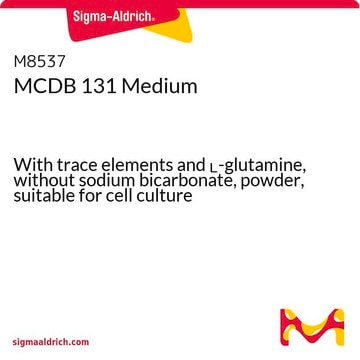M6770
MCDB 201 Medium
With trace elements, L-glutamine and 30 mM HEPES, powder, suitable for cell culture
Synonym(s):
MCDB medium
Sign Into View Organizational & Contract Pricing
All Photos(1)
About This Item
UNSPSC Code:
41161501
NACRES:
NA.75
Recommended Products
Quality Level
form
powder
technique(s)
cell culture | mammalian: suitable
components
HEPES: 7.149 g/L (30mM)
glucose: 1.441 g/L (Dextro)
phenol red: 0.001242 g/L
sodium pyruvate: 0.055 g/L
L-glutamine: 0.14615 g/L
shipped in
ambient
storage temp.
2-8°C
General description
MCDB 201 medium is a modified Ham′s nutrient mixture F-12 that is synthesized for the clonal growth of chicken embryo fibroblasts.
Application
MCDB 201 Medium has been used as a component of:
- the hepatic differentiation medium to culture pluripotent stem cells,
- epididymal growth medium for culturing of preadipocytes,
- Dulbecco′s Modified Eagle Medium (DMEM)/F12 for culturing of human umbilical cord mesenchymal stem cells
Quantity
Formulated to contain 17.7 grams of powder per liter of medium.
supplement
Product No.
Description
Pricing
Storage Class Code
11 - Combustible Solids
WGK
WGK 1
Flash Point(F)
Not applicable
Flash Point(C)
Not applicable
Certificates of Analysis (COA)
Search for Certificates of Analysis (COA) by entering the products Lot/Batch Number. Lot and Batch Numbers can be found on a product’s label following the words ‘Lot’ or ‘Batch’.
Already Own This Product?
Find documentation for the products that you have recently purchased in the Document Library.
Customers Also Viewed
Jeff Ishibashi et al.
Molecular and cellular biology, 32(12), 2289-2299 (2012-04-05)
Fibroblastic preadipocyte cells are recruited to differentiate into new adipocytes during the formation and hyperplastic growth of white adipose tissue. Peroxisome proliferator-activated receptor γ (PPARγ), the master regulator of adipogenesis, is expressed at low levels in preadipocytes, and its levels
Baris Ulum et al.
Journal of cellular physiology, 233(11), 8429-8436 (2018-05-26)
Bone marrow mesenchymal stem cells (BM-MSCs) are promising candidates for regenerative medicine purposes. The effect of obesity on the function of BM-MSCs is currently unknown. Here, we assessed how obesity affects the function of BM-MSCs and the role of endoplasmic
Philip Roelandt et al.
Methods in molecular biology (Clifton, N.J.), 997, 141-147 (2013-04-03)
Differentiation of human stem cells to hepatocytes is crucial for industrial applications as well as to develop new therapeutic strategies for liver disease. The protocol described here, using sequentially growth factors known to play a role in liver embryonic development
Philip Roelandt et al.
PloS one, 5(8), e12101-e12101 (2010-08-17)
Stem cell-derived hepatocytes may be an alternative cell source to treat liver diseases or to be used for pharmacological purposes. We developed a protocol that mimics mammalian liver development, to differentiate cells with pluripotent characteristics to hepatocyte-like cells. The protocol
Jeff Ishibashi et al.
Molecular and cellular biology, 32(12), 2289-2299 (2012-04-05)
Fibroblastic preadipocyte cells are recruited to differentiate into new adipocytes during the formation and hyperplastic growth of white adipose tissue. Peroxisome proliferator-activated receptor γ (PPARγ), the master regulator of adipogenesis, is expressed at low levels in preadipocytes, and its levels
Our team of scientists has experience in all areas of research including Life Science, Material Science, Chemical Synthesis, Chromatography, Analytical and many others.
Contact Technical Service









